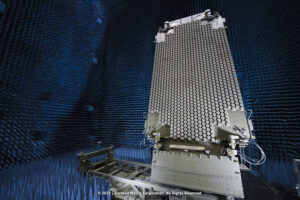Following Norway’s move to become the first international customer for Lockheed Martin’s [LMT] new TPY-4 long-range radar, the company said it has seen a “significant amount” of interest from potential international and domestic customers in the system.
Chandra Marshall, Lockheed Martin’s vice president of radar and sensor systems, told Defense Daily on Thursday that over 30 different potential customers have visited with the company over the last six months to see the TPY-4 radar perform live tracking.

“I can’t get into specific countries but I will tell you, over the course of the last few months, we have had a significant amount of both domestic and international folks come to Syracuse and actually witness the TPY-4 radar doing live tracking out at our Cazenovia site in New York,” Marshall said in an interview.
Lockheed Martin is currently producing the TPY-4 radar for the U.S. Air Force’s Three-Dimensional Expeditionary Long-Range Radar (3DELRR) program to replace the service’s legacy TPS-75 radar.
The Air Force said in March that Lockheed Martin beat out Northrop Grumman [NOC] to provide the new 3DELRR radar, after both companies had received integration contracts under the preceding SpeedDealer program (Defense Daily, March 11).
Lockheed Martin officially received the first production order for two TPY-4 radars on March 29, with the 3DELRR program including options to potentially provide up to 35 of the new radars.
On Nov. 17, Norway then signed a contract with Lockheed Martin to supply eight of its TPY-4 radars as the country’s future air surveillance capability, with options for three additional radars, becoming the first international customer for the system (Defense Daily, Nov. 18).
“Norway was able to take advantage of an active production line, which really made this a low-risk solution for them,” Marshall told Defense Daily on Thursday.
Norway’s first TPY-4 radar is expected to be in place by the end of 2025, with deliveries to be completed by 2030.
Lockheed Martin has noted that Norway’s Kongsberg is a key part of its TPY-4 team, as it builds the radar’s Platform Electronics SubSystem.
“We worked significantly with the Norwegian [defense] industry, specifically with Kongsberg Defence & Aerospace, when we were building up the first production unit for TPY-4 during the competition phase for 3DELRR,” Marshall said on Thursday. “As we see additional international interest, which we have seen significant interest, [then] we’ll continue to partner with Kongsberg and with those efforts in the production of TPY-4.”
On the domestic side, Marshall cited potential interest as it relates to NORAD’s North Warning System, which currently utilizes Lockheed Martin’s FPS-117 radar.
“We have the FPS-117 radars that have been operating in support of that. TPY-4 does represent a generational leap in the performance of those systems and is well-suited to replace systems like that,” Marshall said.
During a media visit to the company’s facility near Syracuse in late April officials noted the first TPY-4 radar was set to begin 15 months of open-air testing at its nearby site in Cazenovia, New York (Defense Daily, April 27).
“What’s the significance of the [TPY-4] radar? When you talk about it in an unclassified manner, it’s able to identify and track smaller targets at longer ranges than any of the previous radars that have been in the field today. It’s also multi-mission and is able to integrate with basically any existing air defense system,” Marshall said. “One of the other key pieces of the technology is it can operate in heavily-contested environments. That’s a huge advancement over systems that are in the field today.”
Marshall also noted the software-enabled nature of TPY-4 allows for more seamless upgrades to the radar as the mission set evolves.
“What we really focus on with these [TPY-4] radars is they can be adapted to new missions through software enhancements, without having to change to hardware. That is really a focus for all of our radars because, obviously, hardware modifications are costly and you have to take the radars out of the field to do that,” Marshall said.